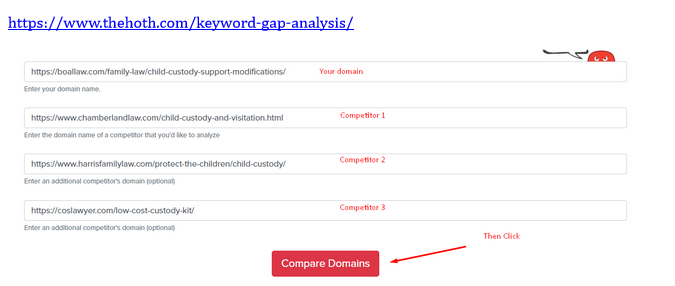SUPERCHARGE YOUR ONLINE VISIBILITY! CONTACT US AND LET’S ACHIEVE EXCELLENCE TOGETHER!
Importance of Content GAP Analysis:
This analysis involves identifying keywords that are relevant to the website’s niche and comparing the website’s existing content with that of its competitors. The goal is to identify keywords and topics that the website’s competitors are ranking for, but the website is not. This analysis helps to identify content gaps, which can be filled with new content that targets those keywords and topics.

This analysis involves identifying keywords that are relevant to the website’s niche and comparing the website’s existing content with that of its competitors. The goal is to identify keywords and topics that the website’s competitors are ranking for, but the website is not. This analysis helps to identify content gaps, which can be filled with new content that targets those keywords and topics.
Understanding Content Gap Analysis
Content gap analysis is a strategic process used in content marketing and search engine optimization (SEO) to identify gaps or deficiencies in existing content. It involves evaluating the content on a website or within a specific niche to determine where there are opportunities to create new content that addresses user needs or fills gaps in the information available to the audience.
Purpose and Objectives of Conducting Content Gap Analysis
The primary purpose of content gap analysis is to improve the effectiveness of a content marketing strategy by ensuring that the content produced aligns with the needs and interests of the target audience. The objectives of conducting content gap analysis include:
- Identifying topics or keywords that are not adequately covered by existing content
- Understanding the content landscape within a specific industry or niche
- Uncovering opportunities to create new content that will attract and engage users
- Improving search engine rankings by addressing gaps in content coverage
- Enhancing the overall user experience by providing comprehensive and relevant information
Key Components and Steps Involved in Content Gap Analysis
- Identifying Target Keywords and Topics
The first step in content gap analysis is identifying the target keywords and topics relevant to the website or business. This involves conducting keyword research to determine the terms and phrases that users search for about the products, services, or topics the website covers.
- Assessing Existing Content Inventory
Once the target keywords and topics have been identified, the next step is to assess the existing content inventory. This involves reviewing all the content available on the website, including blog posts, articles, landing pages, and other resources. The goal is to determine which topics are already covered and which must be included or represented.
- Identifying Gaps in Content Coverage
After assessing the existing content inventory, the next step is identifying content coverage gaps. This involves comparing the target keywords and topics to the content currently available on the website. Areas without existing content or where the content is insufficient or outdated are considered gaps that need to be addressed.
- Analyzing Competitor Content
In addition to evaluating the content on your website, it’s important to analyze the content produced by competitors. This can provide valuable insights into topics and keywords that are popular within your industry or niche and help identify areas where your content may be lacking.
- Prioritizing Content Creation Based on Identified Gaps
Finally, once gaps in content coverage have been identified, it’s important to prioritize content creation efforts. This involves determining which topics or keywords represent the greatest opportunities for attracting and engaging users, improving search engine rankings, and achieving business objectives. By prioritizing content creation in this way, you can ensure that your efforts are focused on producing content that will have the greatest impact on your target audience.
Exploring the Benefits of Content Gap Analysis:
Enhanced Relevance and Authority:
By identifying and addressing gaps in content coverage, you can establish your blog as a go-to resource within your niche. By providing comprehensive and relevant information, you enhance the credibility and authority of your blog, driving increased user engagement and loyalty.
Improved Search Engine Rankings:
Content gap analysis enables you to optimize your blog for relevant keywords and topics, improving its visibility in search engine results pages (SERPs). By addressing gaps in content coverage and targeting high-value keywords, you can attract organic traffic and boost your search engine rankings.
Targeted Content Creation:
By prioritizing content creation based on identified gaps and opportunities, you can ensure that your efforts are focused on topics and keywords that resonate with your target audience. This targeted approach allows you to create content that addresses specific user needs and preferences, leading to higher engagement and conversion rates.
Competitive Advantage:
Gaining insights into competitor content and identifying areas of differentiation can give you a competitive advantage in your niche. By filling gaps in content coverage and offering unique perspectives, you can position your blog as a leader within your industry, attracting new audiences and retaining existing ones.
Unlocking the Benefits of Topic Cluster Optimization:
Enhanced Content Relevance and Authority:
Topic cluster optimization allows you to create a cohesive content strategy that covers a wide range of related topics within your niche. By organizing your content into clusters, you enhance the relevance and authority of your blog, making it more attractive to both users and search engines.
Improved Search Engine Visibility:
By linking pillar pages to cluster content through internal linking, you create a hierarchical structure that signals the relationship between different topics to search engines. This helps search engines understand the context and relevance of your content, leading to improved visibility and higher rankings in SERPs.
Facilitated User Navigation:
Topic cluster optimization makes it easier for users to navigate your blog and discover relevant content. Organizing your content into clusters and providing clear pathways between pillar pages and cluster content creates a user-friendly browsing experience that encourages exploration and engagement.
Sustainable Growth and Scalability:
By adopting a topic cluster approach, you create a scalable content strategy that can accommodate your audience’s evolving needs and interests. As you expand your blog and create new content clusters, you establish a foundation for sustainable growth and long-term success.
Step By Step Guide To Perform Content Gap Analysis And Topic Cluster Optimization
Step 1: Find you focus keywords and competitive related page
Focus Keyword: child custody lawyer colorado springs
Your domain: https://boallaw.com/family-law/child-custody-support-modifications/
Competitor 1: https://www.chamberlandlaw.com/child-custody-and-visitation.html
Competitor 2: https://www.harrisfamilylaw.com/protect-the-children/child-custody/
Competitor 3: https://coslawyer.com/low-cost-custody-kit/
Step2: Put all the Step1 detail in the below website and then click to compare

Here is the below list for related keywords
https://docs.google.com/spreadsheets/d/1LkWiSZ6ewp2i57e1bXYOo2pyjpHPKFqupnRvX7_LdFA/edit?usp=sharing
Note: Now we need to select those key which are related to our website niche.
- Here are some related keywords
- child support attorney
- child custody attorney
- child custody lawyers
- colorado child support
- child support lawyers
- child support colorado
- child support attorney near me
- affordable child custody lawyers
- colorado child custody laws
Recommendation: So, we need to write a fresh SEO friendly content for this page. This content help to improve their website’s search engine rankings, increase traffic, and ultimately drive conversions.
Topic Clusters Optimization Using Python
Using this Python tool we can create a topic cluster from a large number of random keyword list, using those topic cluster we can write blogs.
Step 1:
Create a folder on desktop –
Create a TXT file on that folder and rename it to “keywords”
Now go to any keyword research tool and extract large number of keywords from a broad topic.
For example –
We have searched a broad topic on Seranking keyword research tool –
And the tool provided a large number of random keywords, now we have group them to create topic cluster –
Got 1149 keywords –
Now copy those keywords and paste on that previously created TXT file. And save it.
Step 2:
import csv
import numpy as np
from sklearn.cluster import AffinityPropagation
from sklearn.feature_extraction.text import TfidfVectorizer
# Read keywords from text file
with open(“keywords.txt”, “r”) as f:
keywords = f.read().splitlines()
# Create a Tf-idf representation of the keywords
vectorizer = TfidfVectorizer()
X = vectorizer.fit_transform(keywords)
# Perform Affinity Propagation clustering
af = AffinityPropagation().fit(X)
cluster_centers_indices = af.cluster_centers_indices_
labels = af.labels_
# Get the number of clusters found
n_clusters = len(cluster_centers_indices)
# Write the clusters to a csv file
with open(“clusters.csv”, “w”, newline=””) as f:
writer = csv.writer(f)
writer.writerow([“Cluster”, “Keyword”])
for i in range(n_clusters):
cluster_keywords = [keywords[j] for j in range(len(labels)) if labels[j] == i]
if cluster_keywords:
for keyword in cluster_keywords:
writer.writerow([i, keyword])
else:
writer.writerow([i, “”])
Save the code as python on that folder –
Now open anaconda prompt –
And go to that folder using cd command –
Now install those PIPs –
pip install scikit-learn
pip install numpy
Now run the python code –
python topic.py
After running this code, an excel file will be exported to your folder –
Result:
Open the clusters file –
As we can see the tool has analysed the keyword list and created a group for topic cluster.
Recommendation:
We will create blogs using those keyword group/cluster.
And interlink them to optimize topic cluster.

